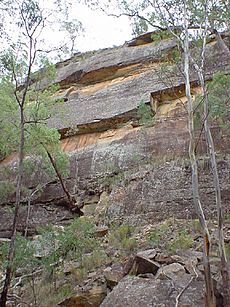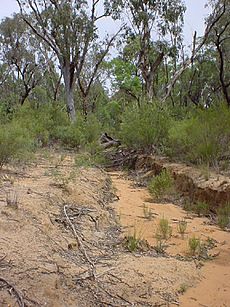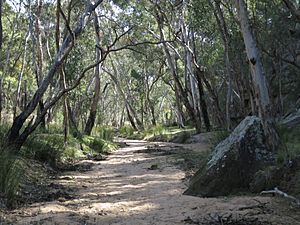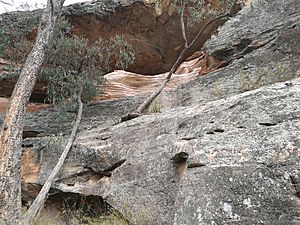Pilliga forest facts for kids
The State Forests of The Pilliga, also called the Pilliga Scrub, covers an area of 3000 km2 in north-central New South Wales, Australia. It is the largest area of semi-arid woodland in the state. The forest is near the towns of Baradine and Narrabri and the villages of Pilliga and Gwabegar.
Contents
History
Author Eric Rolls wrote a book about the Pilliga called A Million Wild Acres. He argued that the forest used to be an open woodland forest and that European influence has let the cypress pines take over. However, many scientific authors now disagree, using historical records from as early as the 1870s which say that the types of plants in the forest have not changed as much as Rolls suggests. However most of his history of the region is an important document for understanding the area.
Environment
Geology
The geology of the area is mainly Pilliga sandstone. This is a coarse red to yellow Jurassic sandstone containing about 75% quartz, 15% plagioclase and 10% iron oxide.In the south are sandstone outcrops with basalt-capped ridges. In the north there are plains of alluvium from flooding creeks. There are small, shallow, usually dry lakes, called gilgais, in some areas. In the west there are dry sandy creeks, called "sand monkeys". In the east is a heavily eroded sandstone mountain range, which can be seen as sandstone outcrops such as those around Gin's Leap between Baan Baa and Boggabri.
Flora and fauna
The forest contains at least 900 plant species. Some areas of the forest, particularly in the western Pilliga, are dominated by cypress-pine (Callitris spp.). However there are a variety of other plant communities in the forest, some of which do not include Callitris. These include smaller she-oaks, while eucalypts are the taller trees throughout the forest.
Animals found in the Pilliga Nature Reserve include at least 36 native and nine introduced mammals, 50 reptiles and at least 15 frogs. Squirrel Gliders, Koalas, Rufous Bettongs and Pilliga Mice are present.
Birds
A 4909 km2 area of land, including the forest and the nearby Warrumbungle National Park, has been identified by BirdLife International as an Important Bird Area (IBA). It supports groups of Painted Honeyeaters and Diamond Firetails. Endangered Swift Parrots and Regent Honeyeaters, and near threatened Bush Stone-curlews, are sometimes seen in the forest. Other woodland birds present in good numbers include Barking Owls, Glossy Black-Cockatoos, Grey-crowned Babblers, Speckled Warblers, Brown Treecreepers, Hooded Robins and Turquoise Parrots.
Fires
Fire plays a major role in the ecology of the forest with many plant species needing fire to regenerate. Sometimes the fires can be extremely hot, spread very quickly and threaten nearby properties as well as laying waste to entire ecosystems. If these fires occur less than 15 years apart there can be a loss of plant and animal biodiversity. The size of the Pilliga bushfires is linked to the El Nino Southern Oscillation phenomena, with El Nino (dry) years having the most severe fires.
In 1997 a major fire burned about 1,435 km² of the forest. An extremely dry winter and spring in 2006 saw a number of large fires develop, including the Pilliga 4 Fire in November/December which burned out 740 km² on its first day.
Access and attractions
There many roads in the forest, many of which are former forestry roads. There used to be a large forestry industry, cutting cypress pine and ironbarks. In 2005 the NSW government protected much of the forest for environmental conservation.
There are many attractions in the forest, including:
- Sculptures in the Scrub: A series of cculptures along the beautiful Dandry Gorge
- Salt caves: shallow sandstone caves in the middle of the Pilliga
- Dandry Creek Gorge: sandstone cliff toward the south of the Pilliga
- Pilliga Pottery: off the highway north of Coonabarabran
- Bird-watching: many species of birds occur in the forest; the Baradine Visitor's Centre has information leaflets
Images for kids












